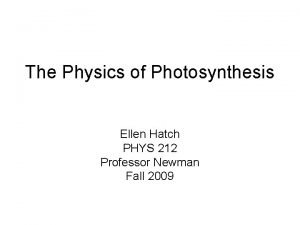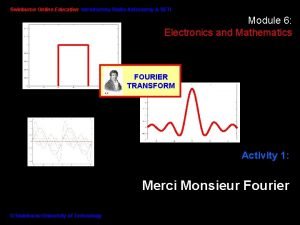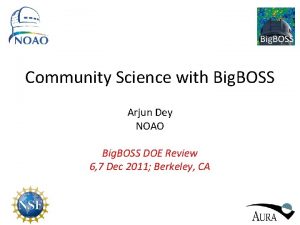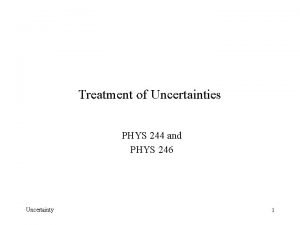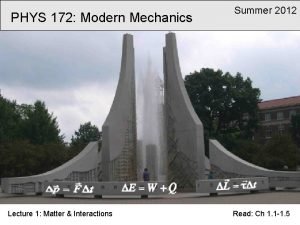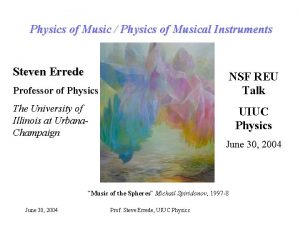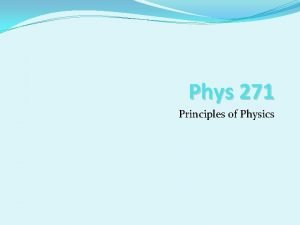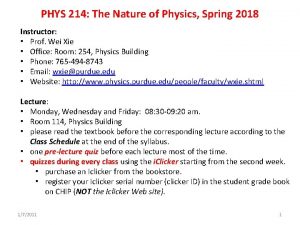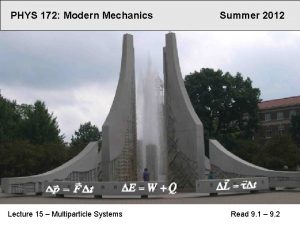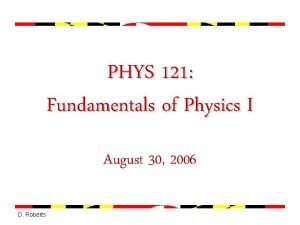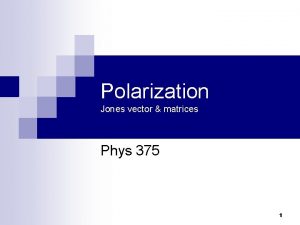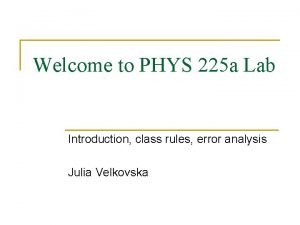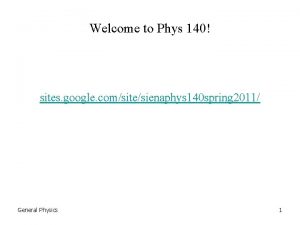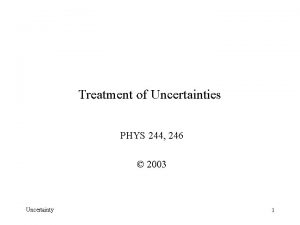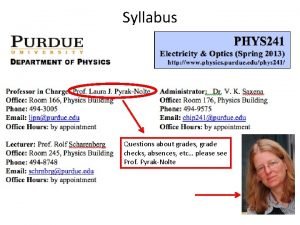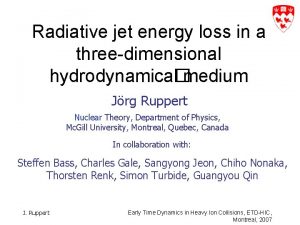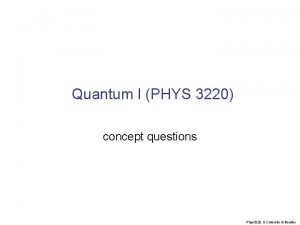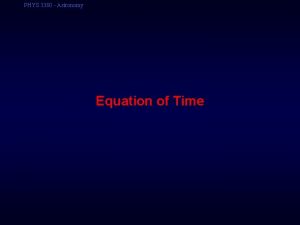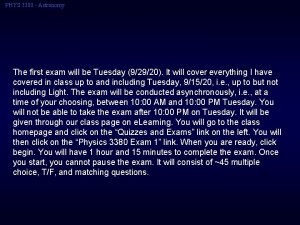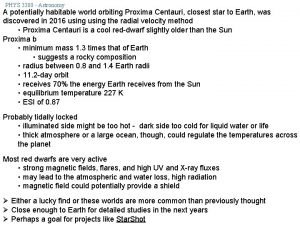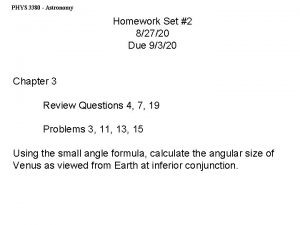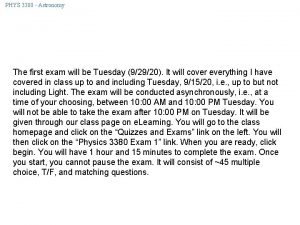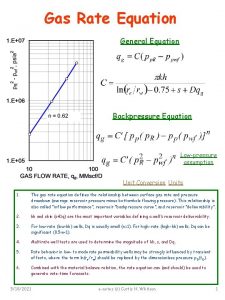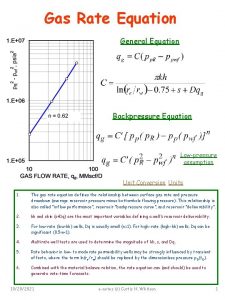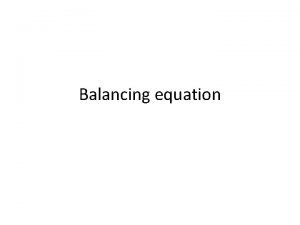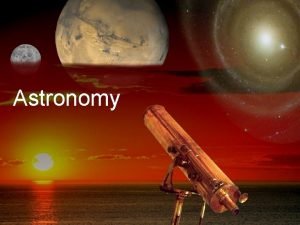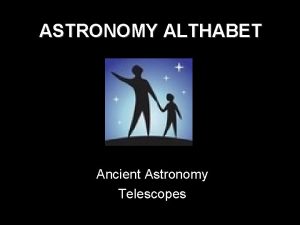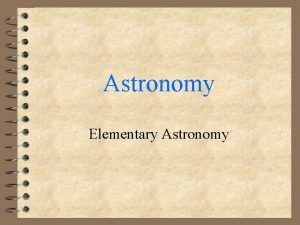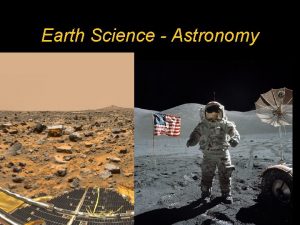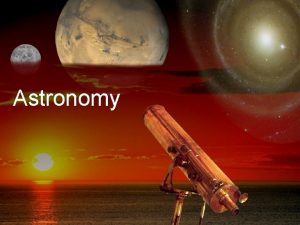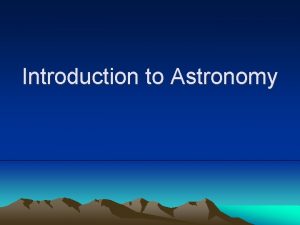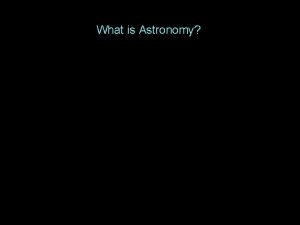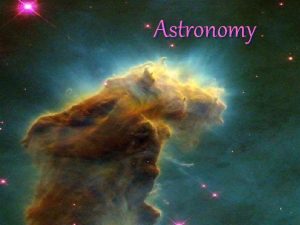PHYS 3380 Astronomy Equation of Time PHYS 3380
































- Slides: 32

PHYS 3380 - Astronomy Equation of Time

PHYS 3380 - Astronomy Elliptical Orbit Effect Elliptical orbit means orbital velocity varies - (Kepler’s 2 nd Law). - greatest at perihelion - in January - smallest at aphelion - in July In January, Earth is traveling faster than average - at the end of 24 hours each Earth has rotated approximately 361 degrees

PHYS 3380 - Astronomy Superimpose the orbits - after 24 hours: - sun appears to be directly overhead on Earth “A”. - sun is NOT directly overhead on Earth “B” has not quite rotated far enough relative to the sun. Looking at your watch on Earth “B” at noon - appears that the sun's position slightly to the east. Error in time accumulates and the sun will continue to appear to move farther and farther east in the sky. - error accumulates until April 2 - maximum offset to east - from April 2 to July 3 - sun drifts back to west - reaches maximum westward offset on October 2

PHYS 3380 - Astronomy mean anomaly (M) - the fraction of the orbital period that has elapsed since the last passage at periapsis (perehelion) z, expressed as an angle. true anomaly (T) is the angle between the direction z-s of periapsis and the current position p of an object on its orbit, measured at the focus s of the ellipse eccentric anomaly (E) - the angle between the direction of periapsis z and the current position of an object on its orbit, projected onto the ellipse's circumscribing circle perpendicularly to the major axis, measured at the centre of the ellipse.

PHYS 3380 - Astronomy M T true anomaly - angle (as seen from the Sun) between the Earth and the perihelion of the orbit of the Earth equal to 0 degrees at perihelion. equal to 180 degrees at aphelion. mean anomaly - what the true anomaly would be if the Earth moved with constant speed along a perfectly circular orbit around the Sun in the same time. equal to 0 at perihelion and 180 degrees at aphelion - only places true and mean anomalies are equal

PHYS 3380 - Astronomy Effect of Elliptical Orbit on Equation of Time (Assume no axial tilt in discussion) Effect equal to difference between mean anomaly and true anomaly G is the gravitational constant, m is the planetary mass, a is the semimajor axis, t is the time from perihelion e is the eccentricity, r is the orbiting body’s position vector e is the eccentricity vector - points toward perihelion with magnitude e=|e| (1) (2) (3) (4)

PHYS 3380 - Astronomy (5) (6)

PHYS 3380 - Astronomy

PHYS 3380 - Astronomy

PHYS 3380 - Astronomy

PHYS 3380 - Astronomy Effect of Axial Tilt on Equation of Time (Assume no ellipticity in discussion) Path of the Sun between March 21 and March 22 If no axial tilt, motion of sun horizontal only - at noon every day, sun appears at highest point in the sky (culmination) only drifting slightly east against background of stars represents Mean Sun that would travel on the celestial equator. In reality, sun drifts slightly east and to the north (or south) depending on the season - represents True Sun that travels in the ecliptic.

PHYS 3380 - Astronomy View of True Sun (red) and Mean Sun (blue) over year - both travel at constant speed - speed of projection on equatorial plane different - in same position at vernal and autumnal equinoxes. Looking at top view - start together but True Sun lags Mean Sun until May, then begins to catch up, catching it at summer solstice. True Sun appears in the sky to the right of Mean Sun between vernal equinox and summer solstice - culminates before the Mean Sun.

PHYS 3380 - Astronomy Note: Axial tilt calculations are done in degrees and ellipticity calculations are done in radians.

PHYS 3380 - Astronomy

PHYS 3380 - Astronomy

PHYS 3380 - Astronomy Summation of the Effects of Tilt and Eccentricity on the Equation of Time You MUST add the effect of tilt and eccentricity to get the total equation of time: On May 4, the Equation of Time for the ellipticity effect is -396 s and the effect of tilt is 587. 8 s, so the total (the effect of tilt + the effect of ellipticity) is: 587. 8 s – 396. 0 s = 191. 8 s

PHYS 3380 - Astronomy Synodic Month vs Sidereal Month Synodic month - the time it takes for the moon to complete its cycle of phases - or to come back to the same position with respect to the Earth-Sun line - about 29 1/2 days Sidereal month - the time it takes for the moon to complete one orbit relative to the position of the stars - about 27 1/3 days

PHYS 3380 - Astronomy Synodic vs Sidereal Month Animation

PHYS 3380 - Astronomy Tropical vs Sidereal Year Sidereal year – 365. 25636 days - time it takes for Earth to complete one orbit relative to the stars or the time for the Sun to return to the same position in respect to the stars - the orbital period of the Earth – 365. 25636 days Tropical year - 365. 242191 days - calendar year - time from spring equinox to spring equinox about 20 minutes shorter than a sidereal year - because of precession. Changes not only the orientation of Earth’s axis but the location in Earth’s orbit of the seasons. 26, 000 year precession period means that location of solstices and equinoxes among the stars shifts by 1/26, 0000 around the orbit. 1/26, 000 th of a year is about 20 minutes.

PHYS 3380 - Astronomy A tropical year is about 365. 242191 days long - requires leap year every 4 years to keep solstices and equinoxes on same calendar date. After 100 years, in error by more than 3/4 day: 100 tropical - (75 years + 25 leap years) = 36524. 2191 -36525 = 0. 7809 days Skip leap year every 100 years – on the century mark (1700, 1800, 1900) After 400 years error of nearly a day: 400 tropical years - (304 regular years + 96 leap years)=146, 096. 876 146, 096 = 0. 876 So add a leap year every 400 years. (2000 was a leap year) Earth’s rotation slowing - tidal drag - add about 29 leap seconds every 100 years.

PHYS 3380 - Astronomy Leap Seconds Ephemeris Time - the average mean solar time between 1750 and 1890 (centered on 1820) - the period during which the observations on which Simon Newcomb's Tables of the Sun, which formed the basis of all astronomical ephemerides from 1900 through 1983, were performed. Universal Time (UT) - timescale based on the rotation of the Earth. - a modern continuation of the Greenwich Mean Time (GMT), i. e. , the mean solar time on the meridian of Greenwich, England. ØEphemeris Time and Universal Time are different because the Earth’s rotation is slowing down due primarily due to tidal friction ΔT - the time difference obtained by subtracting Universal Time from Ephemeris Time.

PHYS 3380 - Astronomy Initially, second defined as 1/86, 400 th of a mean solar day in the year 1820. Now use stable atomic clocks one second =time for a cesium atom to make 9, 192, 631, 770 vibrations Rotation of Earth slowing down - tidal friction, atmospheric circulation, internal effects, transfer of angular momentum to the Moon orbital motion, etc… - the 8. 9 magnitude earthquake in Japan in 2011 that caused the Fukushima reactor meltdown shortened the rotation rate by 1. 8 μs - shifted the main island of Japan by about 8 ft and shifted the Earth’s figure axis (the axis around which the Earth’s mass is balanced) by about 33 ft.

PHYS 3380 - Astronomy To a first approximation: - tidal forces slow Earth's rate of rotation by 2. 3 ms/day/cy. - melting of continental ice sheets at the end of the last ice age removed their tremendous weight - allowed land under them to begin to isostatically rebound upward in the polar regions - continues to this day - causes Earth's rate of rotation to speed up by 0. 6 ms/day/cy. The net tidal acceleration or the change in the length of the mean solar day is +1. 7 ms/day/cy.

PHYS 3380 - Astronomy

PHYS 3380 - Astronomy Actual T varies significantly because of aforementioned effects. - all values of ΔT before 1955 depend on observations of the Moon, either via eclipses or occultations - now, orientation of the Earth relative to an inertial reference frame formed by extra-galactic radio sources is used

PHYS 3380 - Astronomy The rotation rate even varies on a day-to-day basis

PHYS 3380 - Astronomy Modern Time Scales Temps Atomique International (TAI) or International Atomic Time weighted average of the time kept by about 200 cesium atomic clocks in over 50 national laboratories worldwide - available since 1955 UT 1 - timescale defined by the Earth's rotation - computed by the International Earth Rotation and Reference Systems Service (IERS). - TAI was defined such that TAI = UT 1 on January 1, 1958. Coordinated Universal Time (UTC) - basis for legal time worldwide, - TAI became the international standard on which UTC is based on January 1, 1972. - UTC always differs from TAI by an integral number of seconds. - in mid 2005, behind TAI by 32 seconds - difference due to leap seconds periodically inserted into UTC to keep it from drifting more than 0. 9 seconds from UT 1 27 leap seconds since first leap second added in 1972 - last was added on December 31, 2016. (Always added on June 30 or December 31)

PHYS 3380 - Astronomy Leap Seconds: Pros and Cons Dr. Markus Kuhn (University of Cambridge) lists the following arguments against leap seconds: • Leap seconds could cause disruptions where computers are tightly synchronized with UTC. • Leap seconds are a rare anomaly, which is a concern for safety-critical real-time systems (e. g. air-traffic control concepts entirely based on satellite navigation). • Universal Time (UT 1), which is defined by Earth's rotation, is not significant in most people’s daily lives. Arguments in favor of leap seconds include: • There have been no credible reports about serious problems caused by leap seconds. • Some computerized systems that work with leap seconds are costly to modify (eg. antennas that track satellites). • Computer errors caused by leap seconds can be avoided simply by using International Atomic Time (TAI) instead of Universal Coordinated Time (UTC). • Desktop computers and network servers have no trouble coping with leap seconds. • Humankind has defined time by the Earth's rotation for over 5000 years – this tradition should not be given up because of unfounded worries of some air-traffic control engineers. • Abandoning leap seconds would make sundials obsolete.

PHYS 3380 - Astronomy Early Astronomy Most ancient societies recorded astronomical observations for religious or practical purposes - enabled them to keep track of time and seasons - crucial for agricultural societies. Africans used the Moon to predict the annual rainfall pattern orientation of crescent “horns” relative to the horizon told time of year and thus expected rainfall. Why does the horn orientation vary with seasons?

PHYS 3380 - Astronomy Many ancient cultures built structures to mark the seasons. Stonehenge - Sun rose directly over the Heel Stone on the summer solstice The Sun Dagger - New Mexico built by Anasazi to mark summer solstice.

PHYS 3380 - Astronomy

PHYS 3380 - Astronomy
 Learning astronomy by doing astronomy
Learning astronomy by doing astronomy Learning astronomy by doing astronomy activity 7 answers
Learning astronomy by doing astronomy activity 7 answers Learning astronomy by doing astronomy
Learning astronomy by doing astronomy Phys 212 equation sheet
Phys 212 equation sheet Time domain astronomy
Time domain astronomy Time domain astronomy
Time domain astronomy Time domain astronomy
Time domain astronomy Elapsed time
Elapsed time Uiuc physics 102
Uiuc physics 102 Physics 101 uiuc
Physics 101 uiuc Phys courses ucsd
Phys courses ucsd How to calculate experimental uncertainty
How to calculate experimental uncertainty Purdue physics 172 past exams
Purdue physics 172 past exams Physics 241
Physics 241 Http //www.phys.hawaii.edu/ teb/optics/java/slitdiffr/
Http //www.phys.hawaii.edu/ teb/optics/java/slitdiffr/ Http //vsg.quasihome.com
Http //vsg.quasihome.com Phys 398 uiuc
Phys 398 uiuc Coloumb units
Coloumb units What does att phys mean in medical terms
What does att phys mean in medical terms Hydr root words
Hydr root words Mastering physics login
Mastering physics login Phys 214
Phys 214 Particl clicker
Particl clicker Phys 121 umd
Phys 121 umd Eosc 110 pre class quiz
Eosc 110 pre class quiz Half wave plate matrix
Half wave plate matrix Physics 101 uiuc
Physics 101 uiuc Phys 225
Phys 225 Phys140
Phys140 Phys 244
Phys 244 Purdue phys 241
Purdue phys 241 Phys. rev. c
Phys. rev. c Phys 3220
Phys 3220



